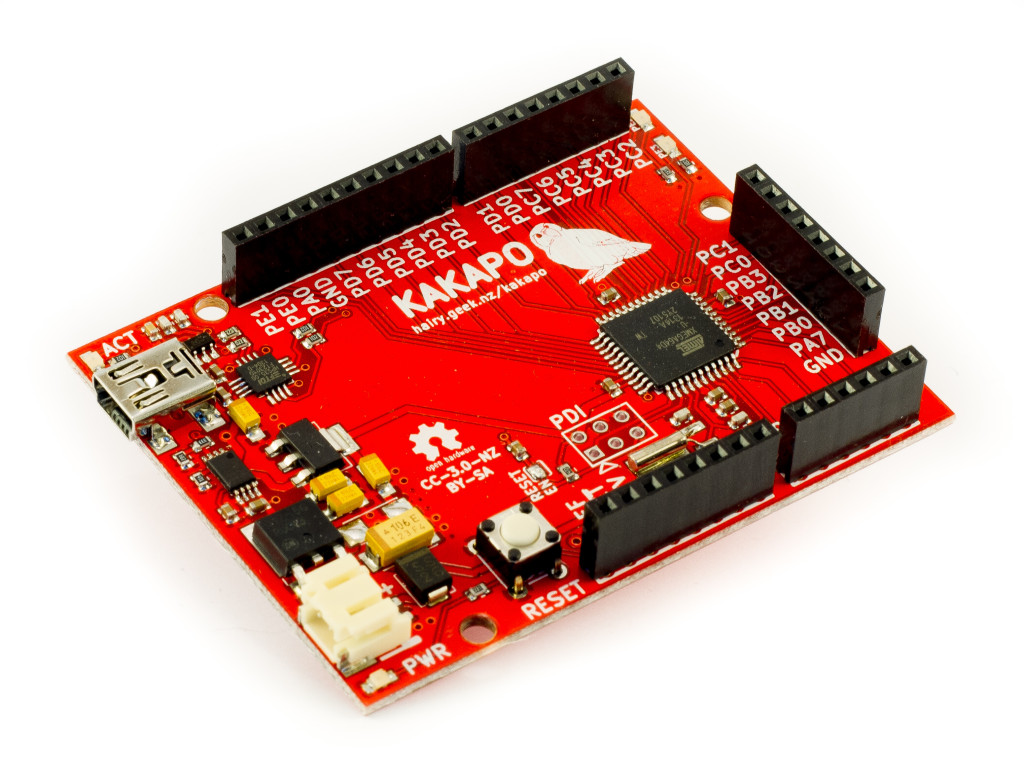Kakapo
 Kakapo is a Atmel AVR XMEGA development board, Arduino style. The board features automatic reset and is loaded with a bootloader so you can upload code with only software and a USB cable, rather than needing a special programming kit. The headers are similar to the Arduino Uno R3, with only a few differences in their features.
Kakapo is a Atmel AVR XMEGA development board, Arduino style. The board features automatic reset and is loaded with a bootloader so you can upload code with only software and a USB cable, rather than needing a special programming kit. The headers are similar to the Arduino Uno R3, with only a few differences in their features.
You can buy one from nicegear here in New Zealand!
Getting Started
- The 2 Minute Guide - for the extremely impatient
- Hello World
- Registers and Hardware
- Pin Modes
Put the initial setup steps guide here. and Hello World.
Boilerplate Drivers - libkakapo
libkakapo provides a set of boilerplate drivers for basic features of most peripherals available. It's not intended to cover every possible usage or situation, instead the goal is to provide enough so you aren't stuck writing your own just to do something similar, while providing a well-commented basis to write your own or extend ours.
libkakapo is provided under a LGPLv2 license.
The various functions of libkakapo, how to get it
Hardware Specifications
- 30 IO pins on user-accessible headers
- 29 Digital capable, 12 feature PWM
- 12 Analog capable including 2 analog reference pins
- 2 USARTS (1 tied to USB bridge)
- 2 SPI interfaces
- 2 TWI interfaces
- 2 user LEDs (not shared with IO headers); PWM capable
- 1 power LED, 1 USB activity LED
- 32.768kHz watch crystal supporting Real Time Clock
- USB or DC powered
- Automatic selection; favours DC when both connected
- No cross-conduct when both sources connected
- No reverse-conduct when only one source connected
- USB input 5V
- DC input 9-12V; JST 2-pin, reverse polarity protected
- 500mA maximum 5V rail from either source
- MCU: Atmel AVR XMEGA 64D4
- 64kB flash + 4kB bootloader; 4kB SRAM
- 32MHz maximum CPU frequency
- IO voltage: 3.3V max (not 5V tolerant); except AREF (2.7V max)
- Bootloader pre-installed (AVR109 compatible)
- USB Bridge: FTDI FT230X
- USB mini-B connector
- Tied to separate USART from traditional shield USART pins
- Powered exclusively from USB; disconnecting USB releases IO header pins
- USB side ESD protected
- Automatic MCU reset via RTS
Production kit includes a USB to mini USB cable.
Important Differences between Arduino and Kakapo
The Kakapo does not have its own development environment or IDE. While it is a similar MCU family to the Arduino, and is strongly influenced by the shield format of an Arduino, there is no support in the Arduino IDE for this board.
You are free to use any development environment, including Atmel's AVR Studio and ASF if you wish. Libkakapo provides an alternative set of lightweight drivers if you don't wish to use ASF or write your own drivers.
Kakapo is also a 3.3V only part, all IO must be at 3.3V and not a higher voltage. Most Arduino boards are 5V, and many shields expect this, so while the Kakapo may physically accept an Arduino shield, it could still damage the shield or the Kakapo.
While we have attempted to keep the header pins the same as an Arduino R3, there are a number of differences. You may wish to review the "Pin mapping and features" link in the reference section below.
Reference
Usage
Datasheets
- Atmel XMEGA 64D4 Datasheet [PDF, offsite]
- Atmel XMEGA D Family Datasheet [PDF, offsite]
- TI TPS2110A autoswitching power mux [offsite]
- NXP NCV1117 1.0A LDO voltage regulator [PDF, offsite]
- FTDI FT230X USB USART bridge [offsite]
- NXP IP4220CZ6 Dual USB 2.0 ESD Protection [offsite]
Hardware Source
- Version 1.0 (current)
- Schematic [PDF]
- Kicad Source Files [ZIP]
- Kicad Library for shields (schematic and footprint) [ZIP]
- Mechnical Drawing [PNG]
License
Kakapo original documentation, schematics, and PCB layout is provided under the Creative Commons New Zealand 3.0 Share-alike Attribution license. Copyright 2009-2014 David Zanetti.
libkakapo, and related examples, are provided under the GNU Lesser General Public License version 3. Copyright 2009-2014 David Zanetti.